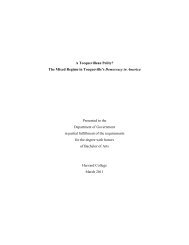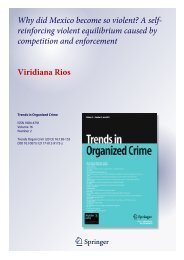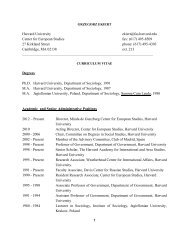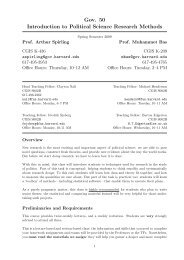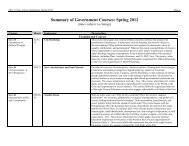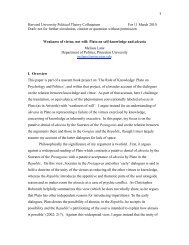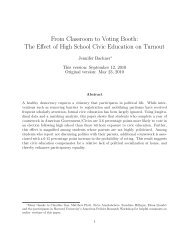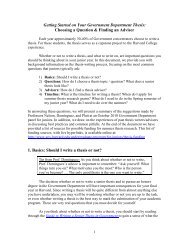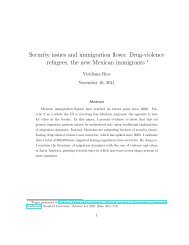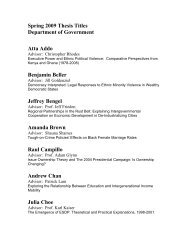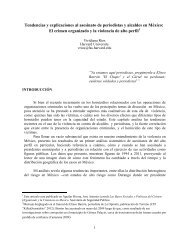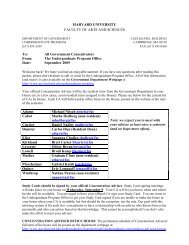Supreme Court Agenda Setting in a System of Shared Powers Ryan ...
Supreme Court Agenda Setting in a System of Shared Powers Ryan ...
Supreme Court Agenda Setting in a System of Shared Powers Ryan ...
Create successful ePaper yourself
Turn your PDF publications into a flip-book with our unique Google optimized e-Paper software.
12 The Journal <strong>of</strong> Law, Economics, & Organization. V0 N0<br />
Comb<strong>in</strong>ed, then, these four regimes and the strategic expectations derived<br />
therefrom lead to the follow<strong>in</strong>g hypothesis:<br />
Strategic SOP <strong>Agenda</strong>-<strong>Sett<strong>in</strong>g</strong> Hypothesis: If the location <strong>of</strong> the<br />
Left and Right Pivots, <strong>Court</strong> Median, and Status Quo lead to an<br />
Unconstra<strong>in</strong>ed or Semi-Constra<strong>in</strong>ed Regime, the <strong>Court</strong> will grant<br />
review to a case. Conversely, if the <strong>Court</strong> is <strong>in</strong> a Constra<strong>in</strong>ed<br />
Regime, it will deny review to a case.<br />
4.3 Who Are the Left and Right Pivots? Theories <strong>of</strong> Legislative Decision Mak<strong>in</strong>g<br />
Def<strong>in</strong><strong>in</strong>g who the pivotal legislative actors are is a complicated task. Congressional<br />
scholars advocate equally plausible theories <strong>of</strong> congressional decision<br />
mak<strong>in</strong>g. Some scholars argue that legislation turns on the preferences <strong>of</strong><br />
the median legislator <strong>in</strong> each chamber. Other scholars argue that parties and<br />
committees exercise gatekeep<strong>in</strong>g control over legislation. Still other scholars<br />
contend that super-majority pivots largely dictate legislative outcomes. I rema<strong>in</strong><br />
neutral as to which is correct and therefore apply each <strong>of</strong> them.<br />
The chamber median model argues that legislative outcomes reflect the preferences<br />
<strong>of</strong> the median legislator <strong>in</strong> each chamber (Krehbiel, 1991, 1995). Accord<strong>in</strong>g<br />
to this model, members <strong>of</strong> Congress are elected with concrete preferences<br />
that drive their vot<strong>in</strong>g behavior and, as a result, the median member <strong>of</strong><br />
each chamber controls legislative outcomes (Lawrence, Maltzman and Smith,<br />
2006). That is, parties are simply the conglomeration <strong>of</strong> like-m<strong>in</strong>ded members<br />
who vote their preferences (K<strong>in</strong>gdon, 1973). Thus, the Left Pivot under the<br />
Chamber Median model is the most liberal among the House chamber median,<br />
the Senate chamber median, and the president. The Right Pivot is the most<br />
conservative among the House chamber median, the Senate chamber median,<br />
and the president.<br />
The party gatekeep<strong>in</strong>g model argues that majority party leaders control vot<strong>in</strong>g<br />
procedures to channel outcomes that are preferred by party members (Cox<br />
and McCubb<strong>in</strong>s, 2005). To facilitate legislative outcomes that aid their electoral<br />
chances, legislators create party leadership, whose function is to solve<br />
coord<strong>in</strong>ation problems among party members and pass laws that reflect the<br />
“brand name” desired by the majority party’s median member. Under this theory,<br />
party leadership will only allow legislation to receive an up or down vote<br />
if it will satisfy both the chamber and party medians. That is, the party will<br />
only br<strong>in</strong>g legislation to a floor vote when party leaders expect to w<strong>in</strong>. As<br />
Lawrence, Maltzman and Smith (2006) state: “[T]he majority party manipulates<br />
the amendment agenda so as to restrict the chamber median’s ability to<br />
move outcomes towards that legislator’s preferred po<strong>in</strong>t and away from the majority<br />
party median’s ideal po<strong>in</strong>t” (41). In the end, the majority party obta<strong>in</strong>s<br />
the outcome it wants while still allow<strong>in</strong>g legislators to vote their s<strong>in</strong>cere preferences<br />
on f<strong>in</strong>al passage votes (Lawrence, Maltzman and Smith, 2006, 41). 14<br />
14. The majority party can allow members to vote s<strong>in</strong>cerely on f<strong>in</strong>al passage votes, then, be-



